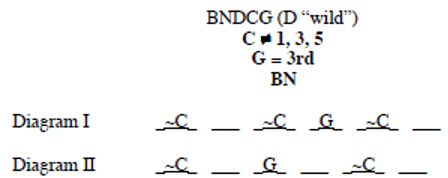Our diagram will consist of six dashed lines, numbered 1 through 6 from left to right. Summarizing this information gives the following schematic:

Now, we decide the most effective order for placing the elements on the diagram. Following the guidelines on page 31, we look for a condition that fixes the position of an element. There is none. Next, we look for a condition that limits the position of an element. The second condition, “Gori is the third person from the left,” limits Gori to spaces 3 and 4. This condition, as often happens with ordering games, generates two diagrams: one with the empty space to Gori's left and one with the empty space to his right:

Next, we look for a condition that connects two or more people. The last condition, BN, connects B with N. However, at this stage we cannot place it on the diagram. Finally, we look for a condition that states where a person cannot be standing. The first condition states that Chohan cannot be standing in space 1, 3, or 5. Noting this on the diagram yields

(Note: D is “wild” because the conditions do not refer to him. Thus D can stand in more positions than any other person.)
This diagram is self-contained. There is no need to refer to the original problem. If possible, always avoid rereading the problem. No further conditions can be derived, so we turn to the questions.
This problem is best solved by the method of elimination. To apply this method take a condition; test it against each answer-choice, eliminating any that violate it. Then take another condition; test it against the remaining answer-choices, eliminating any that violate it. Continue until only one answer-choice remains. Many students apply every condition to the first answer-choice, then every condition to the second answer choice, and so on. This should be avoided since it’s inefficient; however, sometimes there is no other option. Because this question type is relatively easy, it often is the first or second question asked.
The first condition contradicts choice (A) since Chohan cannot be first. It does not contradict the other choices. So eliminate (A) only. The second condition contradicts choice (B) since Gori must be 3rd. It does not contradict the remaining choices. So eliminate (B) only. The third condition contradicts choices (C) and (D) since in neither choice is Bushra to the immediate left of Nasir. It does not contradict the remaining choice. So eliminate (C) and (D) only. Thus, by process of elimination, we have learned the answer is (E).
To answer this question, we had to test all the conditions; often, however, we will find the answer before testing the last condition.